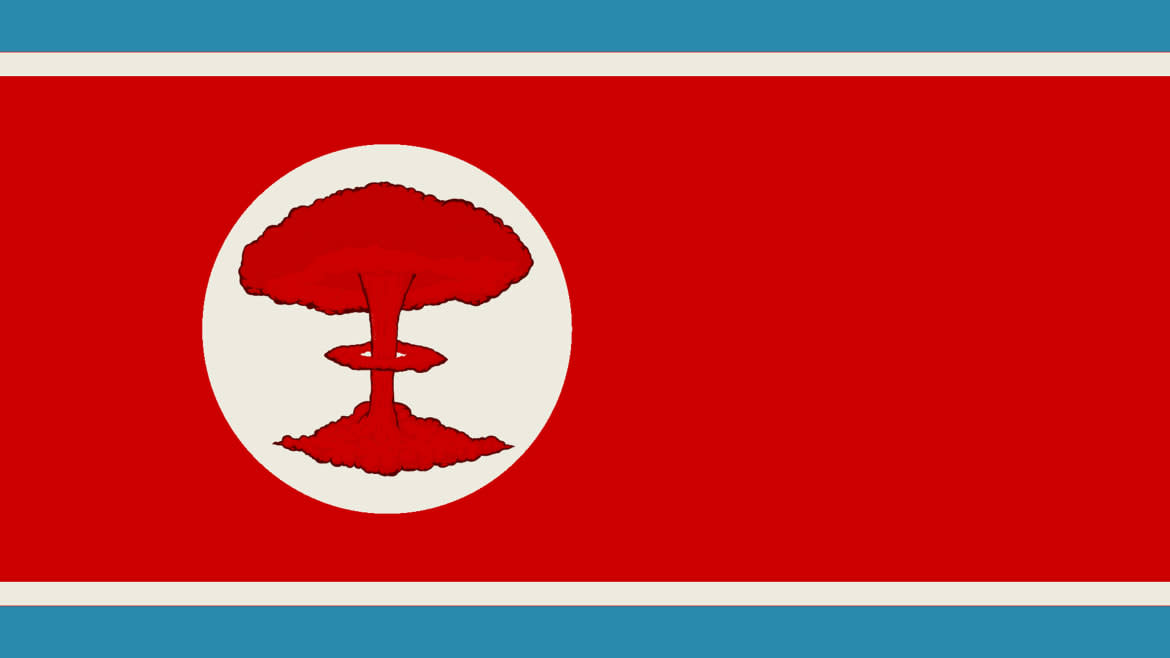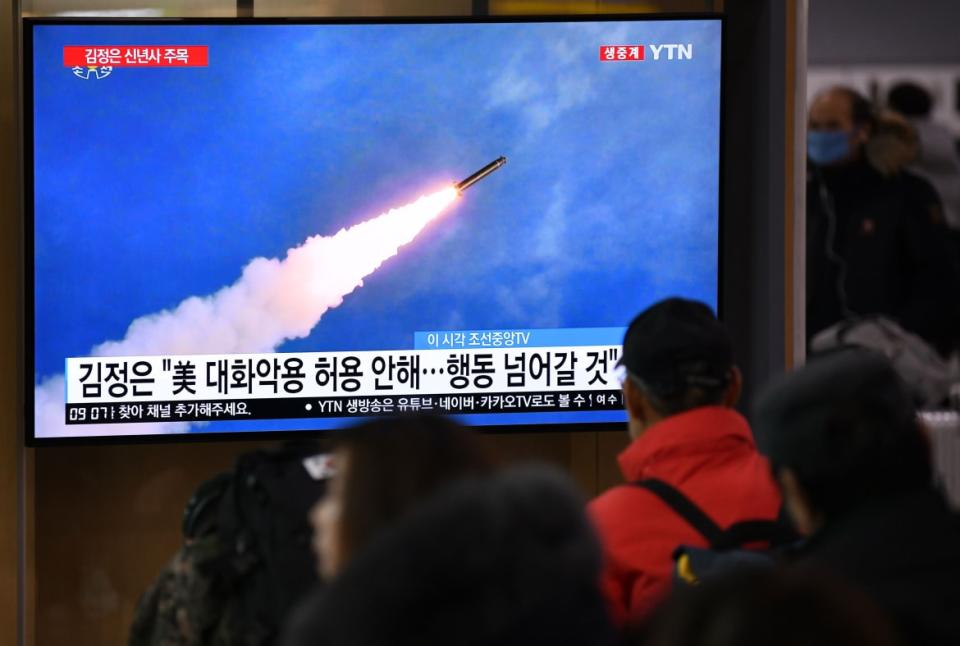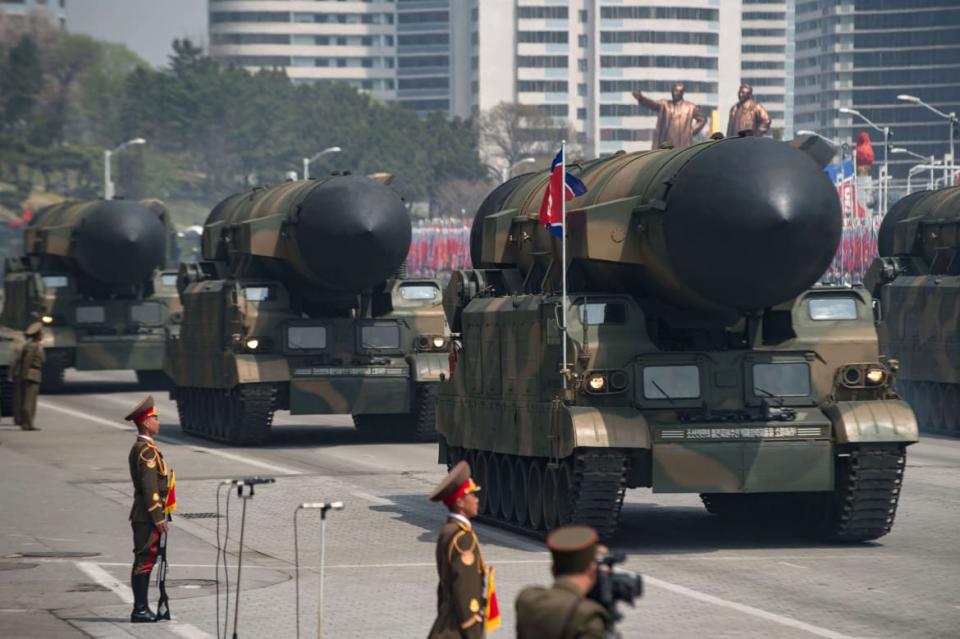The Secret Weapons Scheme Spiraling Under America’s Nose

- Oops!Something went wrong.Please try again later.
SEOUL—North Korea is producing chemical and bio-warfare weapons capable of inflicting as much death and destruction as the nuclear warheads that U.S. diplomats demand the North stop producing.
That’s according to a lengthy study just released by the RAND Corporation and South Korea’s Asan Institute for the benefit of policy-makers in Washington and Seoul. The study says North Korea “has apparently amassed a substantial inventory of chemical weapons (reportedly 2,500 to 5,000 tons”) plus “an unknown quantity of biological weapons” and “a very active cyber hacker force.”
Among key findings, the report accuses the North of “apparently testing chemical and biological weapons on people and carrying out some assassinations with chemical weapons,” notably that of Kim Jong Un’s older half-brother, Kim Jong Nam, by a VX chemical as he was about to fly from Kuala Lumpur, Malaysia, in February 2017.
In addition, it says, “North Korea has actively employed its cyber capabilities in peacetime to collect information, steal money, and cause damage”—most notoriously the hack of Sony Pictures in 2014 for The Interview, a wildly satirical comedy making wicked fun of Kim Jong Un.
“In wartime,” the report warns, North Korea “would likely employ all of its weapons of mass destruction and cyber capabilities, including nuclear weapons, hoping to win the conflict and avoid suffering regime destruction.” The whole panoply of North Korean WMD (weapons of mass destruction), says the report, “would substantially transform the nature of a major war in Korea,” inflicting “immense damage” on South Korean and American “military capabilities and civil society.”
What to Make of North Korea’s Twisted COVID ‘Revenge’ Threat
The North’s chemical weapons would probably be the deadliest in its inventory of weapons of mass destruction. “A a kilogram of VX would be sufficient to kill or seriously injure 200,000 or so people,” says the report, but U.S. and South Korean forces “do not appear to be adequately prepared to counter the damage that would be done by North Korean CW [chemical weapon] use in a major war started by the North.”
Biological warfare would not be quite so deadly but would still rank high in the North Korean inventory. “Effective anthrax attacks would involve the use of far less agent than chemical attacks,” says the report, citing Kim Jong Un’s visit to a biopesticide plant as raising “serious concerns.” “In wartime, North Korea may well decide to use biological weapons,” says the report. “To achieve surprise, the North could carry out only selected bioweapon attacks before its main attack. After the main attack begins, the North would have great incentive to use bioweapons to attack key targets.

People watch a television news program showing file footage of North Korea's missile test, at a railway station in Seoul on January 1, 2020.
Just as devastating, but in a different way, is the potential for North Korea to wipe out anything run by electricity, including the South’s entire electrical system, by detonating a nuclear device as high as 500 kilometers in the atmosphere.
“These electrical fields are generated by the interaction of radiation from the nuclear explosion with molecules of air in the upper atmosphere and by the heated plasma of the weapon debris itself,” says the report. Electrical fields, known as the electromagnetic pulse (EMP), “can potentially damage electrical equipment and electronic devices on the ground.”
And then there’s “the threat of North Korea’s cyber capabilities.” Indeed, “no tool in North Korea’s arsenal has the reach and diversity of potential impact as its offensive cyber capabilities, “ says the report. “At relatively low cost and in fairly short order,” it goes on, the North “can target adversaries overseas”

An unidentified rocket is displayed during a military parade marking the 105th anniversary of the birth of late North Korean leader Kim Il-Sung in Pyongyang on April 15, 2017.
“In terms of lives lost, people injured, and economic losses,” says the report, “a North Korean cyberattack could potentially cause between zero and thousands of deaths.”
The report scolds the Americans for having failed to seriously punish North Korea for its nuclear and missile tests. The U.S. and South Korea, it said, must warn Kim Jong Un of “the potential consequences that would be imposed for those provocations.”
RAND, funded in large measure by Army and Air Force contracts, admonishes Washington policy-makers for their reluctance to go beyond outraged words and sanctions after North Korea’s multiple tests. In March, North Korea launched an intercontinental ballistic missile claimed to have been a Hwasong-17 capable of carrying a warhead to targets anywhere in the U.S.
As North Korea prepares for its seventh underground nuclear test, the report harshly belittles Washington’s wavering responses to North Korea’s aggressive threats against the U.S. and South Korea.
North Korea has not conducted an underground nuclear test since exploding what may have been a hydrogen bomb in September 2017. Kim and his sister, Yo Jong, however, have waxed increasingly vituperative since the South’s conservative President Yoon Suk-yeol authorized the first U.S.-South Korean military field exercises in five years. North Korea denounced the war games, which ended last week, as preparation for “invasion.”
Kim Jong Un’s Latest Missile Test Officially Puts America ‘At Risk’
The report states bluntly that typical warnings of “consequences cannot be idle threats.” South Korea and the U.S. “must have the will to execute them,” it states, “or future deterrence would be undercut.”
“Our clear objective is denuclearization,” Bruce Bennett, senior defense analyst at RAND, who masterminded the report and wrote half of it, told The Daily Beast. Bennett, who has written more than 100 reports for RAND, sought to temper some of its hardline conclusions.
“We really have to be realistic,” he said. “We don’t have a clear U.S. set of objectives.” Rather, “We have to put it in terms that at least the North Korean elites will consider,” he argued. “It’s in our interests to support a degree of individuality.”
The report, however, was largely critical—both of North Korea for its nuclear and missile tests and cyber program and of the U.S. and South Korea for their ineffective responses.
Bennett recommended “putting pressure on Kim Jong Un” by adopting a “carrot and stick” strategy. In response to another ICBM test, he suggested deluging the North with USBs dropped from drones so North Koreans could tune in to South Korean K-pop and dramas, for which Kim has ordered lengthy prison terms.
But he preferred not to appear overly hardline considering opposition to hawkish policies in South Korea and the U.S. “The reality,” he said, “is to develop a consensus, you have to be moderate.”
Get the Daily Beast's biggest scoops and scandals delivered right to your inbox. Sign up now.
Stay informed and gain unlimited access to the Daily Beast's unmatched reporting. Subscribe now.

